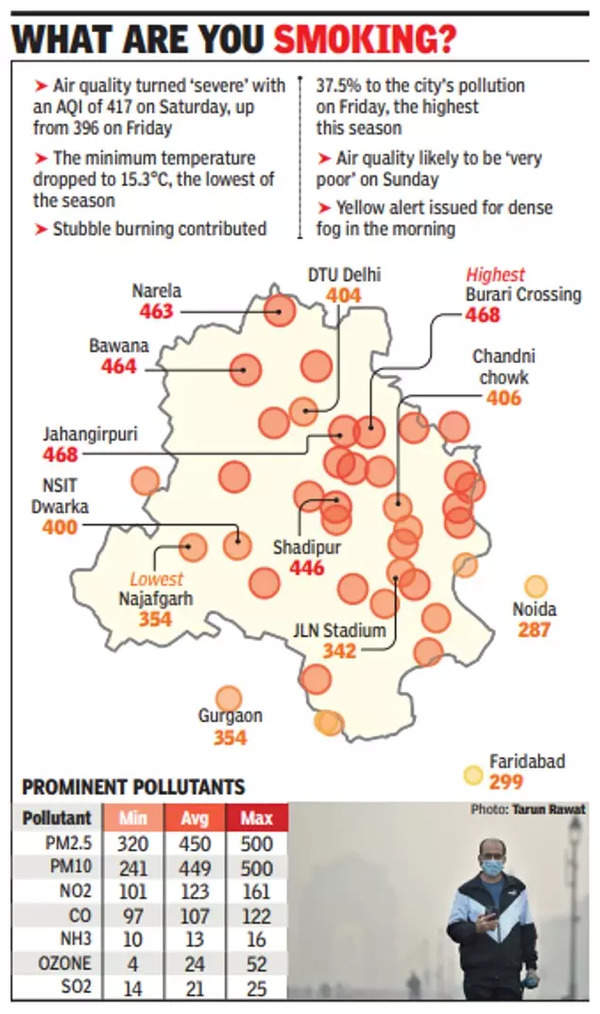NEW DELHI: The city’s air quality slipped to severe levels again Saturday after improving marginally to the higher end of ‘very poor’ the day before, thanks to sluggish weather conditions and a spike in stubble burning (season’s highest share of 37.5%), among other factors.
Bursting of firecrackers in parts of the city on Gurpurab on Friday also added to the pollution. Delhi’s air quality index (AQI), on a scale of 0 to 500, was 407 at 12pm, worsening to 413 by 3pm, 426 by 6pm, and 429 by 7pm. Average AQI of the city on Saturday was 417 against 396 a day earlier.
Neighbouring cities in all directions, though polluted, were doing much better. At 7pm, Greater Noida saw an AQI of 296 (poor), Noida 331 (very poor), Gurgaon 315 (very poor), Faridabad 258 (poor), and Ghaziabad 377 (very poor). Almost all areas in the city remained well within severe levels through the day.
The air quality early warning system indicates weather conditions would not be favourable for dispersion of pollutants in the coming days. The outlook for the next six days: ‘very poor’ air quality.
At 37%, crop burning share in pollution highest this season
The air quality is likely to be in the ‘very poor’ category from November 17, 2024 to November 19, 2024,” the IITM bulletin said.
The share of stubble burning in the city’s air quality increased to the season’s highest of 37.5% on Friday. Weather analysts said the wind speed did not pick up as expected, reaching a maximum of 8 km/h for some time.
The city also saw moderate fog in the morning and a further dip in temperature, which slowed dispersion of pollutants. Minimum visibility at Safdarjung was 200m at 8.30am, while at Palam it was 500m around the same time. IMD has issued a yellow alert for dense fog in the morning.
Weather analysts expect the wind speed to pick up on Sunday, reaching up to 15 km/h, which may slightly help the situation.

The minimum temperature on Friday fell to 15.3 degrees Celsius, the lowest this season, while a day earlier, it was 15.6 degrees Celsius, the second lowest this season. Cold northerly and north-westerly winds wafted in from the fresh snow in Himalayan states, impacting Delhi’s temperatures.
The maximum temperature was recorded at 29.6 degrees Celsius, a notch above normal, against 27.8 degrees Celsius a day earlier. IMD expects the maximum and minimum temperatures to hover around 29 and 15 degrees Celsius on Sunday.
Meanwhile, as per DSS, on Saturday, transport was the biggest contributor to local emissions, contributing 12.44% to the city’s PM2.5, while Jhajjar contributed 5.77%, Sonipat 4.3%, and Delhi’s residential units 3.5%. According to CPCB, the PM2.5 levels of the city oscillated between 215.5 to 263 micrograms per cubic metre, against national standards of 60 units and WHO’s 15 units for 24 hours. PM10 oscillated between 353 and 399.3 per cubic metre, against the national standard of 100 units and WHO’s 45 units.
The Commission for Air Quality Management (CAQM) held a meeting on Saturday to ensure strict enforcement of measures to control air pollution in National Capital Region (NCR), especially during the current period when the Graded Response Action Plan is in force.
“A crucial meeting to monitor and review the status of implementation of actions under different stages of GRAP was held today under the chairmanship of Dr Sujit Kumar Bajpayee, member, CAQM. During the meeting, it was highlighted that the upcoming winter season is a crucial period, and thus, the actions to be taken under different stages of GRAP are to be implemented in true letter and spirit,” CAQM stated.
Meanwhile, air quality in Noida continued to remain in ‘very poor’ category for the fourth consecutive day on Saturday. The average AQI was 328 on Saturday against 316 on Friday, while the AQI in Ghaziabad touched 363 from 341.
Greater Noida also recorded a marginal surge, reaching 287 from 261.
